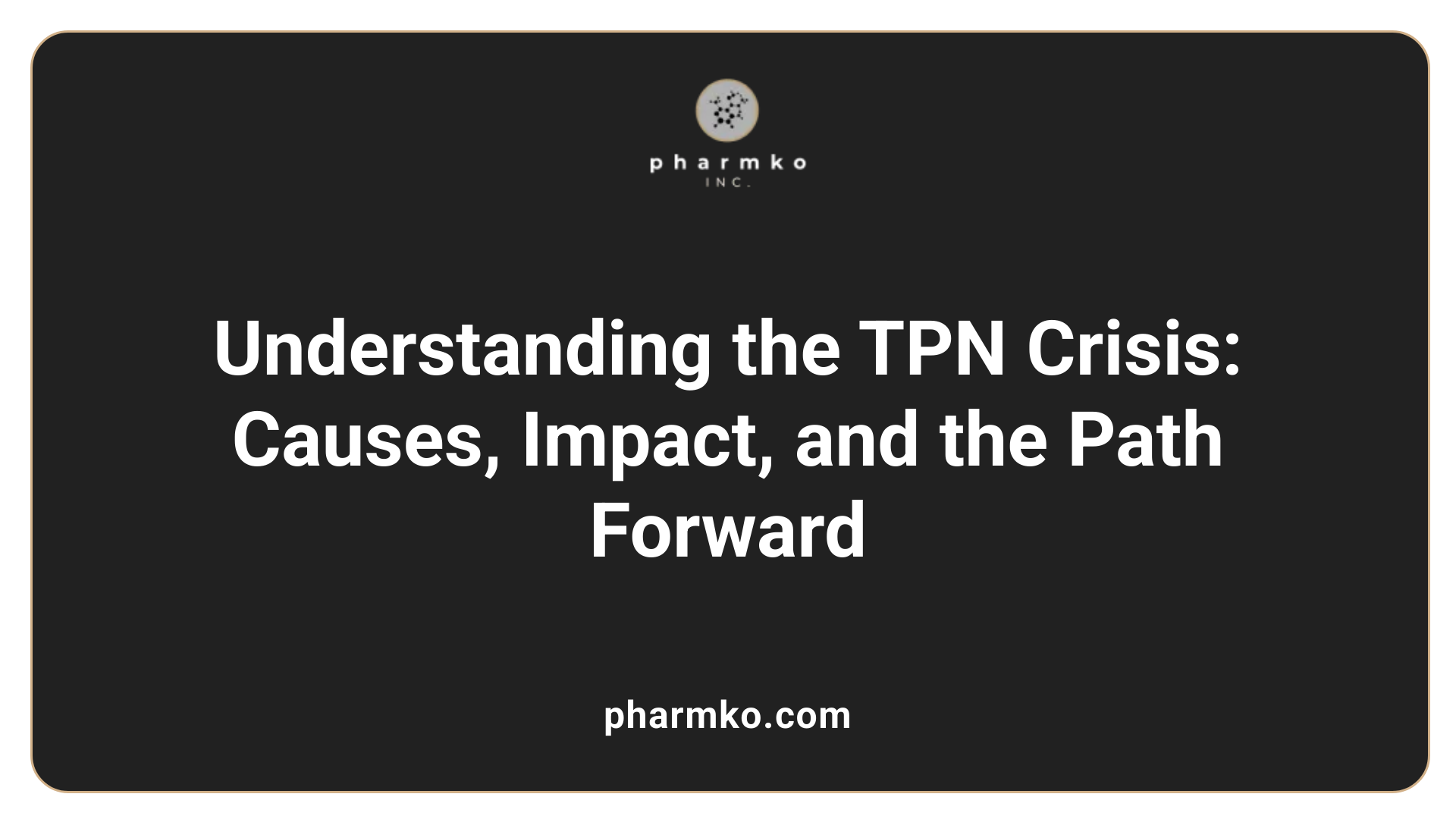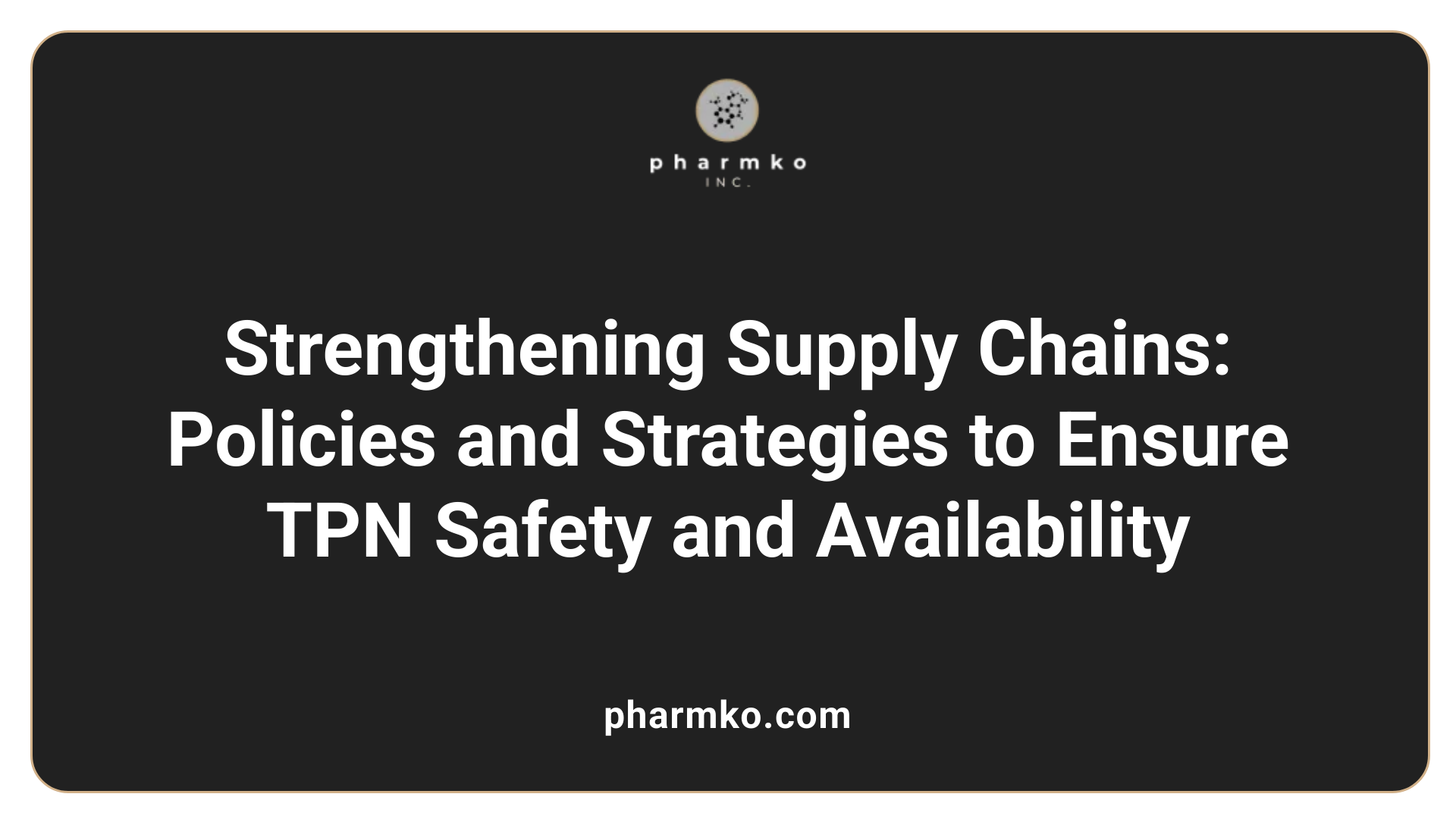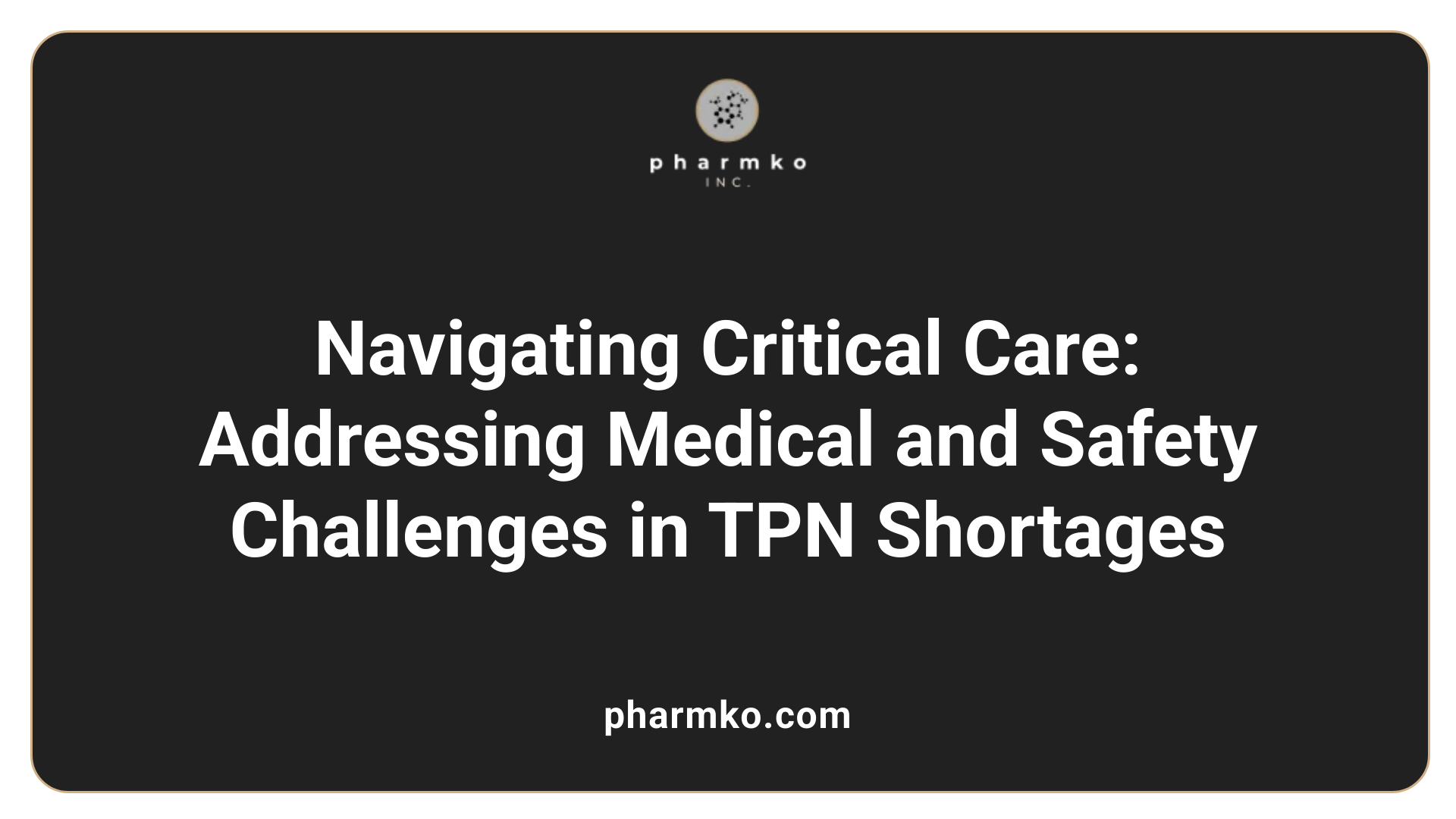National US crisis of TPN
Understanding the scope and complexities of the TPN crisis in the United States
The United States is currently grappling with a significant national crisis involving the widespread shortage and safety challenges of Total Parenteral Nutrition (TPN). As a life-sustaining therapy for critically ill and malnourished patients who cannot receive enteral feeding, TPN's supply chain disruptions threaten patient safety, long-term health outcomes, and healthcare system stability. This article explores the multifaceted aspects of this crisis, including its causes, impacts, responses, and the vital role of healthcare professionals in managing this complex scenario.
Background and Scope of the TPN Crisis

Why is TPN therapy gradually discontinued?
Total Parenteral Nutrition (TPN) is a life-saving therapy for patients who cannot meet their nutritional needs through oral or enteral routes. However, it is often gradually stopped to prevent potential metabolic complications. Healthcare providers carefully assess individual patient conditions, monitoring for issues such as rebound hypoglycemia, refeeding syndrome, and electrolyte imbalances. This cautious approach helps the body adjust to reduced nutrient intake without causing harm.
Transitioning from TPN to oral or enteral nutrition involves a step-by-step reduction, allowing the digestive system and metabolic processes to adapt smoothly. During this process, clinicians closely monitor parameters like blood glucose levels and electrolyte balance. This careful management aims to minimize risks and support effective nutritional recovery.
In conclusion, a tailored, gradual discontinuation of TPN ensures patient safety, reduces complication rates, and promotes a seamless transition to other nutritional methods.
What are the causes and contributing factors behind the TPN crisis in the United States?
The current TPN crisis in the United States stems from multiple underlying factors. Historically, supply chain disruptions coupled with manufacturing challenges have led to persistent shortages of essential components like amino acids, vitamins, and electrolytes. Natural disasters, especially hurricanes, have played a significant role by damaging production facilities; for example, Hurricane Helene in 2024 disrupted Baxter International’s manufacturing plant in North Carolina, affecting the supply of intravenous solutions.
Additional contributors include regulatory hurdles, voluntary recalls, business decisions favoring more profitable products, and the discontinuation of certain ingredients by manufacturers. Since around 2010, these issues have resulted in ongoing shortages, forcing healthcare providers to seek alternatives such as importing products or using multi-chamber bags. The COVID-19 pandemic further strained supply chains, while company consolidations and plant closures limited manufacturing capacity.
The combined impact of these factors has created a fragile supply landscape, hampering patient care and prompting strategies like rationing, switching to alternative solutions, and prioritizing high-risk patients during shortages.
What role do healthcare professionals play in managing TPN challenges?
Healthcare professionals are central to managing the complexities of TPN therapy, especially amid ongoing shortages and safety concerns. Their responsibilities include assessing each patient’s nutritional requirements, customizing TPN formulations, and ensuring appropriate delivery.
A multidisciplinary team—comprising physicians, pharmacists, dietitians, and nurses—collaborates to monitor patient responses, prevent complications such as infections or metabolic disturbances, and adjust therapy as needed. They also oversee sterile techniques during compounding and administration to prevent bloodstream infections.
Patient and caregiver education is vital for maintaining safety, recognizing signs of complications, and ensuring proper catheter care. During shortages, professionals may prioritize resources, modify treatment plans, and coordinate with suppliers to secure necessary supplies.
Overall, healthcare providers safeguard patient well-being through vigilant supervision, adherence to safety protocols, and effective communication, particularly during crises that strain supply chains.
What are the health impacts and safety concerns associated with TPN shortages and errors?
The impact of TPN shortages and errors on patient health can be severe. Shortages often lead to delays or substitution of critical nutrients, resulting in deficiencies that delay recovery or worsen outcomes. For instance, a historic shortage of multivitamins in 1988 caused fatal cases of thiamine deficiency, emphasizing the dangers of missing essential micronutrients.
Errors during prescribing, compounding, or administering TPN—such as incorrect electrolyte concentrations or dosing mistakes—pose serious risks, including infections, organ damage, and metabolic imbalances. These errors are heightened during shortages when resource constraints may compromise safety protocols.
The complexity of TPN therapy and reliance on manual compounding make errors more likely, underscoring the need for strict adherence to standardized guidelines and use of technological safeguards. Continuous staff training, vigilant monitoring, and robust safety practices are crucial in minimizing these risks.
Mitigating safety concerns involves proactive planning, strict process controls, and rapid response systems to address supply disruptions or errors. These measures are critical to protecting vulnerable patients and ensuring safe, effective TPN therapy across healthcare settings.
Regulatory and Industry Responses to TPN Shortages

How do regulatory and policy responses address TPN supply and safety issues?
Regulatory and policy initiatives play a vital role in tackling issues related to TPN. A comprehensive approach involves standardizing the entire process—from formulation to administration—aimed at reducing errors and enhancing safety. Organizations such as the American Society for Parenteral & Enteral Nutrition (ASPEN) and the European Society for Parenteral and Enteral Nutrition (ESPEN) publish guidelines that set safety standards and best practices.
In addition to establishing safety protocols, policies promote the integration of technology—such as barcode-assisted systems and electronic health records—to minimize medication errors. Efforts are also made to stabilize the supply chain by encouraging stockpiling, supporting local manufacturing, and implementing protocols for conservation and substitution during shortages. These measures aim to ensure a reliable TPN supply while maintaining the highest safety standards.
Furthermore, strengthening healthcare workforce competence through education and multidisciplinary support teams helps improve patient safety. Continuous updates and international collaboration on guidelines foster global consistency in TPN practices, underscoring the importance of adaptive policies in safeguarding patient health amid supply issues.
What challenges does the industry face in maintaining TPN supply during natural disasters?
Natural disasters pose significant risks to the continuity of TPN supplies. Hurricanes, floods, and other environmental events can damage manufacturing facilities and disrupt distribution networks. For example, Hurricane Helene's impact on Baxter International’s North Cove facility in North Carolina temporarily halted production of intravenous solutions essential for TPN, leading to urgent shortages.
These interruptions compel healthcare institutions to adopt conservation strategies, seek alternative sources, and implement import plans to mitigate shortages. Such crises expose vulnerabilities in the supply chain, emphasizing the need for resilient manufacturing practices, emergency preparedness, and diversified sourcing options.
Industry stakeholders are encouraged to develop contingency plans, enhance facility preparedness, and establish rapid response mechanisms. Building supply chain resilience ensures that essential TPN components remain accessible during natural disasters, preventing patient harm and maintaining continuity of care.
| Response Area | Strategies | Details |
|---|---|---|
| Policy Measures | Standardization, guidelines | ASPEN and ESPEN standards, technology adoption |
| Supply Chain Stabilization | Stockpiling, local manufacturing | Emergency reserves, encouraging regional production |
| Crisis Management | Diversification, contingency plans | Multiple sourcing, rapid response protocols |
| Education and Training | Multidisciplinary teams | Staff competency, tele-education |
| International Collaboration | Guideline updates, data sharing | Global efforts for best practices |
These coordinated responses aim to enhance the safety, quality, and resilience of TPN delivery, ensuring vulnerable patients receive necessary nutrition regardless of environmental challenges.
Medical and Patient Care Challenges During the Crisis

What are the medical challenges and complications associated with the TPN crisis?
The ongoing shortages and disruptions in Total Parenteral Nutrition (TPN) pose serious medical challenges beyond mere nutrient supply issues. Shortages of vital ingredients, such as multivitamins and amino acids, complicate preparation and administration processes, increasing the risk of medication errors, contamination, and adverse patient outcomes.
Clinically, patients dependent on TPN face heightened risks of infections, metabolic disturbances like electrolyte imbalances, and liver issues such as cholestasis and fatty liver disease. Errors during the preparation or administration phase—whether from incorrect admixture or dosing inaccuracies—can lead to severe complications. Recent incidents, including bacterial contamination concerns at manufacturing sites, underscore the hazards involved.
In addition, disruptions may cause micronutrient deficiencies—like thiamine, magnesium, or zinc—further complicating the clinical picture. The case from 1988, where a shortage of multivitamins led to fatal thiamine deficiency and lactic acidosis, exemplifies how shortages can escalate into life-threatening conditions. Overall, the crisis demands vigilant management, stringent safety protocols, and proactive risk mitigation strategies to prevent adverse events.
Addressing the Crisis and Moving Forward
The ongoing TPN crisis in the United States underscores the urgent need for comprehensive strategies to ensure a stable, safe, and effective supply of parenteral nutrition components. Strengthening manufacturing resilience, enhancing regulatory frameworks, and fostering international collaboration are crucial steps to mitigate current shortages and prevent future crises. Equally important is the role of healthcare professionals in adhering to safety protocols, educating patients and caregivers, and managing patient care effectively amidst resource constraints. Emphasizing innovation, preparedness, and interprofessional coordination will be vital in safeguarding vulnerable patient populations and improving outcomes.
References
- Total parenteral nutrition usage trends in the United States
- Parenteral nutrition in clinical practice: International challenges and ...
- Patients who cannot eat food 'fear for lives' - BBC News
- Deaths Associated with Thiamine-Deficient Total Parenteral Nutrition
- Total Parenteral Nutrition, Multifarious Errors | PSNet - AHRQ
- Disruptions in Availability of Peritoneal Dialysis and Intravenous ...
- TPN Life Expectancy: How Long Can Someone Live on TPN Alone?
- Total Parenteral Nutrition (TPN) Frequently Asked Questions
- Traveling With Home TPN is Now a Reality - Nutrishare
- Home Total Parenteral Nutrition (TPN)













